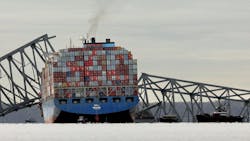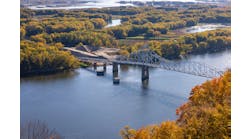In the wake of the collapse of the Francis Scott Key Bridge in March, $60 million in emergency federal funds and numerous salvage vessels have rushed to Baltimore in an attempt to quickly clear the channel to one of the busiest ports in America. The efforts will also set the stage to rebuild the major bridge.
According to experts who spoke with Politico about the salvage and reconstruction, the initial attempts at clearing the channel mark the opening act of a much longer, multi-year effort to rebuild the structure.
In the meantime, the closure of the port has major economic implications for the regional economy and supply chains across the United States: Thousands are already out of work as the port sits silent, while the economic impact to the region while the port is closed clocks in at over $191 million per day.
“This is not a normal project, and we’re not right at the beginning of following a normal process,” said Ben Schafer, a professor of engineering at Johns Hopkins University, in a statement. “Seven years to me seems like the over-under for full reconstruction of the bridge. It’s not a question of technology or engineering, it’s a clear-eyed assessment of what it will take to do it politically and socially.”
But even after the salvage efforts of clearing away thousands of tons of steel are done, government officials and engineers will face a number of questions and considerations in rebuilding.
Span length is the first consideration. The Key bridge had a span length of 1,200 feet, but that didn’t keep the Dali from smashing into one of the pillars. Engineers might consider increasing the span length of a future bridge, to account for the larger cargo vessels that will pass in and out of the port throughout the 21st century.
The next consideration is the structure itself. The original Key bridge, built in the 1970s, was a continuous steel truss design, a collection of trusses on four supports that was the standard for those kinds of span lengths in the 1970s.
Nowadays, cable-stayed bridges, which support the roadway using a series of cables attached to soaring pillars, are the norm for crossing of those lengths. A change in bridge design could extend the reconstruction timeline.
Finally, there are concerns about how quickly bureaucracy can move to actually approve such a massive construction project.
Jim Tymon, the executive director of the American Association of State Highway and Transportation Officials (AASHTO), said governments had shown in recent decades that it’s able to expedite permitting to rebuild key transportation infrastructure.
He pointed to the Interstate 35W bridge collapse in Minneapolis in 2007. In that case, officials built a new bridge in a little over a year. But the span length there was short, and engineers were able to use a similar bridge design to the original for reconstruction.
A better comparison might be the Sunshine Skyway bridge in Tampa Bay, which partially collapsed in 1980 after a freighter hit a support pillar. That bridge took seven years to rebuild from the time of its collapse.
Tymon said that federal and state governments had learned valuable lessons from the I-35W and Sunshine Skyway collapses about how to marshal resources quickly and expedite the permitting process, and he hoped that the Key bridge reconstruction would happen quicker.
In the meantime, for the thousands who are out of work due to the Key bridge collapse, time is of the essence. “We’re just trying to keep them calm,” said Scott Cowan, the president of the International Longshoremen’s Association Local 333 in Baltimore, in a statement about the longshoremen who work in the port. He said that of the 2,400 in his local, only 250 to 300 are currently working.
----------------------------------------
Source: Politico



